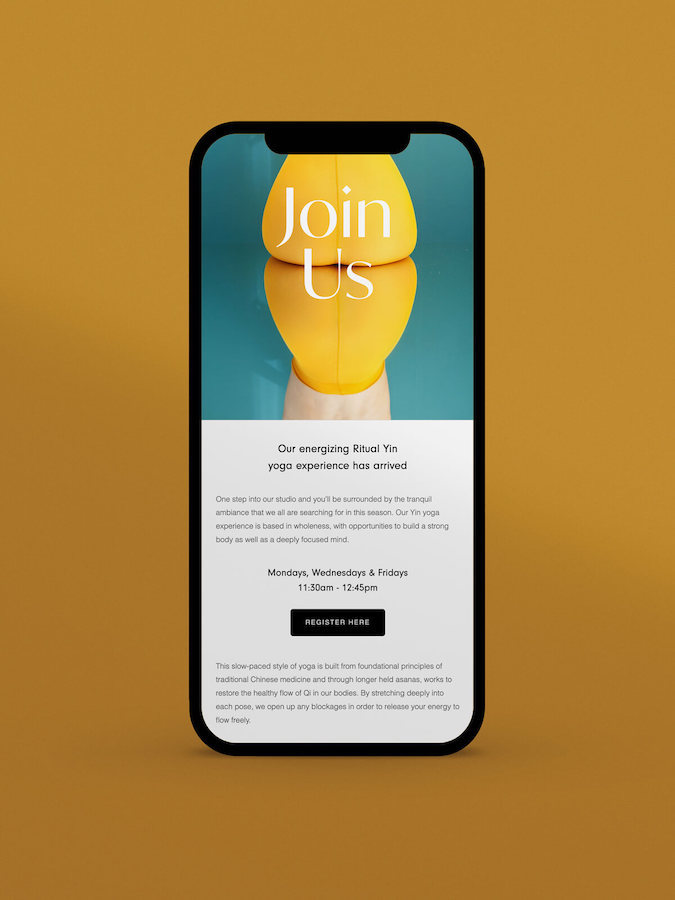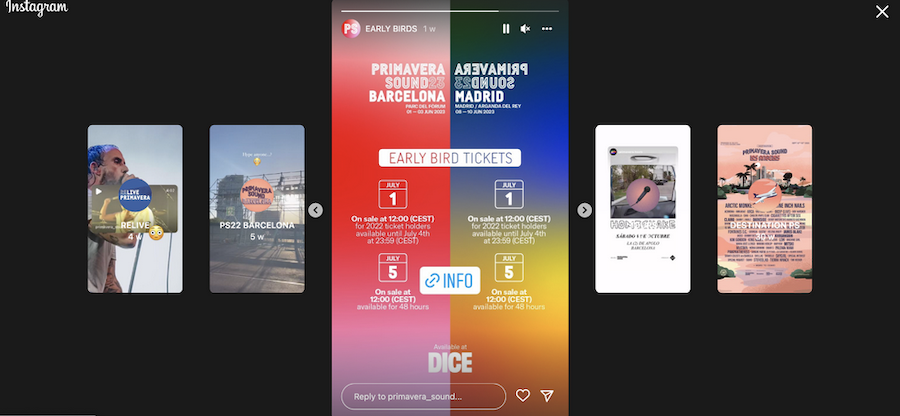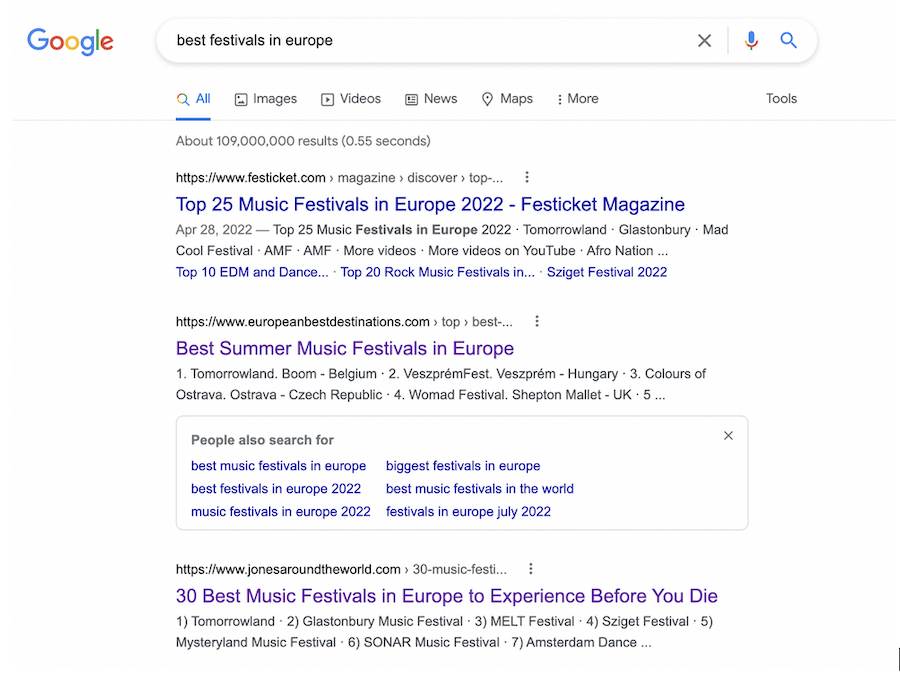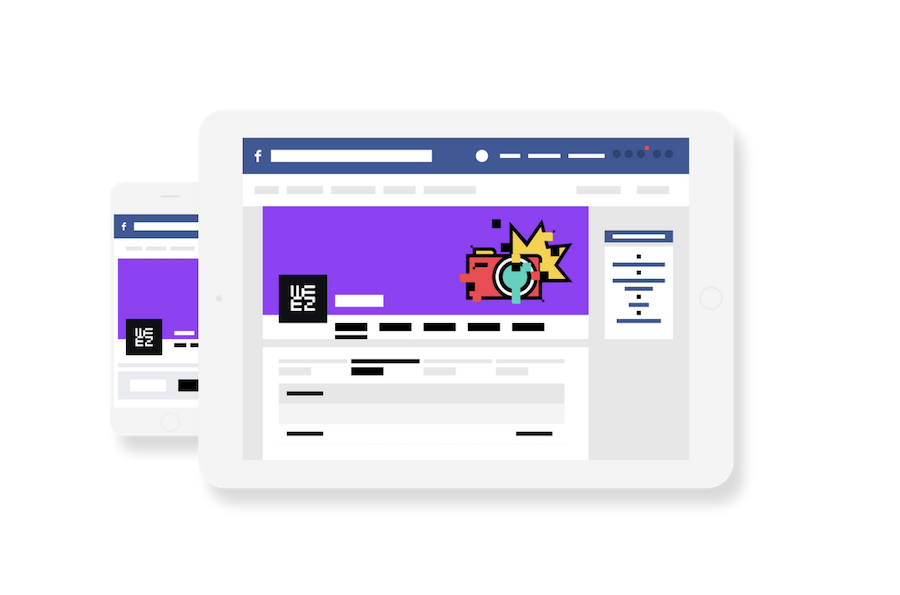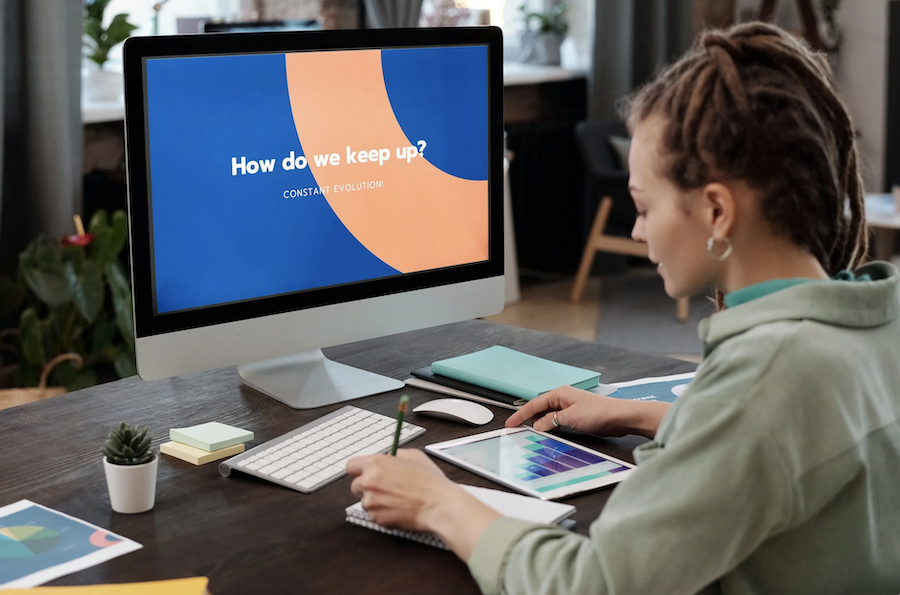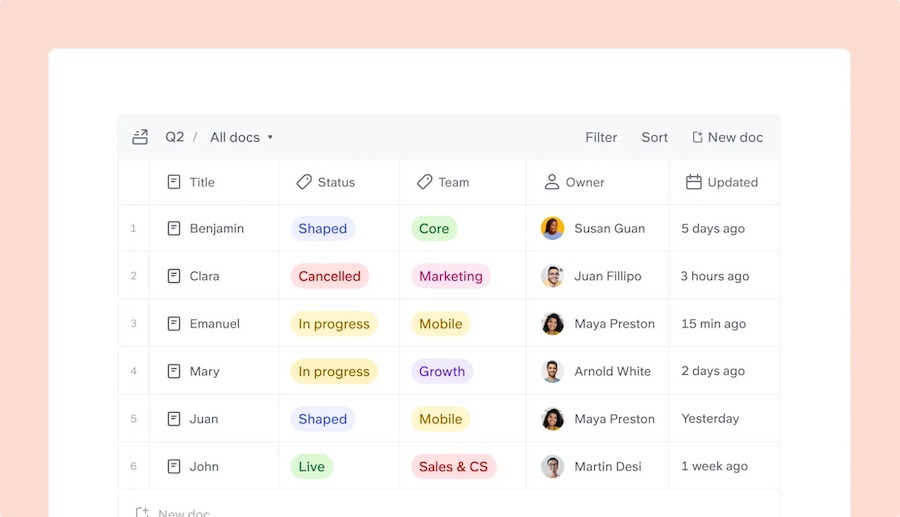10 Tips For Creating Your Festival Communication Plan
So you’ve got a festival on the horizon and need to get your festival communication plan perfect to build hype around your event, keep your staff on side, and sell as many tickets as possible.
Well, you’re in the right place. We’re about to dive into ten tips for creating a festival communication plan to help a successful event.
a) What is a festival communication plan?
b) Tips for an external communication plan
c) Tips for an internal communication plan
d) How to optimize your communication plan
a) What is a festival communication plan?
A festival communication plan is a strategy you put together to ensure all internal and external stakeholders clearly understand the festival. The communications could cover anything from sales goals to ticket availability, depending on who you’re talking to.
A festival communication plan is typically broken down into three parts. Pre, during, and post-event. Each type of communication will have its own set of goals and objectives.
b) Tips for an external communication plan
External communication refers to your communications with potential customers and festival-goers.
Here we’ll explore five ways you can better communicate with your audience to ensure they know the event’s ins and outs and are most likely to purchase tickets and get their friends to do the same.
1. Design unique product launch emails
2. Social media promotional strategy
3. Get featured on listicles
4. Build an SEO content strategy
5. Make it easy to pay
1. Design unique product launch emails
The average email open rate is at 30%.
This is a pretty huge number considering the average click-through rate on a paid ad is sitting at a measly 2%.
Email marketing repeatedly proves that it’s well worth the investment, especially when promoting your festival.
It’s a great idea to design unique product launch emails that correspond with your early-bird ticket sales. This email flow can be anything from 3-5 emails and should get people excited about the ticket drop date. The best practices for building emails that convert are: designing unique product launch emails that
– Leave plenty of white space
– Optimize for mobile
– Consider load speeds
– Use clear CTAs
– Make the most of the subject line & preview text
– Give receivers the option to opt-out and reply directly
If you put these tips into practice for your email communications, you’ll be more likely to win opens, clicks, and sales for your festival tickets.
2. Social media promotional strategy
If it didn’t happen on social media, did it even happen?
Social media is a total game-changer for any event. It’s a critical tool to build hype, track the event live, and relive the glory days once the event is over.
There are plenty of social media strategies to promote an event; however, let’s look at one of the most exciting strategies for this article. TikTok.
The rapidly growing platform has over 1 billion monthly active users, with 90% of users using the app daily.
Moreover, 49% of users say TikTok has helped them make purchasing decisions, and your chance for virality is quite high.
With TikTok, your festival or event account doesn’t need thousands of followers to climb the ranks and get in front of new eyes.
Your content needs to speak to a niche, use popular trends, hashtags, and sounds, and you’re in with a fighting chance of coming out on top with the algorithm.
Figure out a comms strategy for the platform, and, if done right, your festival will quickly take off.
3. Get featured on listicles
Getting featured in listicles or other high-ranking domains within your niche is a popular SEO tactic known as link-building.
In short, this tactic sees high domain authority websites referencing your website as an industry leader for whatever anchor text they use to link to you, as well as the context around your website link.
However, we’re not just looking at getting your festival website to rank higher on Google—although that’s certainly a plus.
We’re looking for genuine links in listicles that your fan base will be searching for. So, understand your niche and what they’re searching for online, and do the same.
Are they looking for:
“The best festivals in 2023”
“Cheap festival tickets”
“Must-go festivals in Europe this holiday season”
“Number one drum and bass festival in London”
How specific are they likely to get?
Do your research on your users, and search as they would.
Find those listicles you need to feature in and reach out to the publishing site. Typically the site will charge you a small fee or, if you’re lucky, will believe your festival deserves a spot on their list.
This way, you build domain authority and social authority among your demographic.
4. Build an SEO content strategy
Flying off the back of our last point, there’s much more to SEO than off-page. You’ve also got an entire on-page strategy and technical strategy to consider if you really hope to get on that all-important first page of Google.
When it comes to on-page SEO, you’ll want to focus on things such as:
– Keyword research: to better understand the words and queries your target audience is using and build content to answer that.
– Meta titles and meta descriptions: to ensure you give your blogs and web pages maximum potential to win a click through.
– Blog content: to run multi-media blog content that gives your audience value and insights around the festival.
– Images: to rank in Google image search and give your readers a brain break. They’re also great for summarizing what you’re trying to get across in words.
– Internal links: to keep users on your website and to help Google navigate your site better.
When it comes to technical SEO, you’ll want your website to focus on things like:
– Site speed: a fast-loading site will see users staying on your page for longer, it also helps you rank.
– Information architecture: to allow Google and users to navigate your site easier.
– Readability/accessibility: to allow Google and site visitors to consume information easier.
Of course, there’s so much more to SEO than listed above. But, take this as a starting point, and if you’re in it for the long run with your festival, then it’s well worth investing in.
5. Make it easy to pay
There’s a high chance you’ve probably heard about the importance of the user experience (UX) when it comes to the usability of your website. UX considers how easily someone can navigate your website, how accessible it is for them, its load speed, and its readability.
It’s an important factor to keep in mind as 88% of online shoppers say they won’t return to a website after having a bad user experience.
Of course, your entire website needs to provide a smooth UX. However, more than anywhere else, it’s crucial that you make purchasing tickets easy for your festival-goers.
Limit clicks, offer various payment options, and make their buying journey as smooth as it should be to ensure they complete their purchase.
Pro tip: Don’t be afraid to sprinkle your checkout page with UGC of festivals gone by and plenty of social proof to ensure ultimate FOMO and drive that final sale.
That’s five tips covering your external communications plan.
When you have these channels running smoothly, you’ll maximize your potential ticket sales, as well as get your festival in front of the right people. Let’s get into how to manage things internally.
c) Tips for an internal communication plan
An internal communication plan is going to look a little different.
This plan is to ensure your workforce is as prepared as possible to sell more tickets, run a smooth event, and ensure the event lives beyond its designated days. Let’s get into it.
6. Solidify your staff scheduling plan
7. Build out sales collateral
8. Keep stakeholders up-to-date
9. Keep your event top of mind (countdown)
10. Segment your comms (Slack channels)
6. Solidify your hotel staff scheduling plan
First up, you’ll need to ensure your on-site team is taken care of.
Ensure your staff scheduling is in order so your team knows the shifts they’re working and where. Your on-site team during an event is just as important as your pre-event sales team.
Each one is a cog in your festival machine to ensure your customers have the best experience possible.
Understand the human resources you’ll need and when, and ensure you’re giving your team plenty of rest between shifts so they can come to work feeling their best—especially if your festival will span across multiple days!
No one wants a repeat of Fyre festival.
7. Build out sales collateral
Now you know you’ve got all your eggs in a row for staffing, you can start to work on selling those tickets, and this will need the support of a sales team.
Of course, if marketing is doing a great job and your website is user-friendly, then sales shouldn’t need such a big input here. However, when it comes to different demographics, some groups still prefer to buy over the phone.
Prepare for everything.
Your sales team will need collateral to help them sell.
This comes mostly in the form of sales scripts, so sales teams give the same branded experience that your customers expect after seeing your online communications.
At the same time, your sales team will need to know the ins and outs of your festival, who’s performing, the food and drink available, frequently asked questions, rules & regulations, and ticket pricing options available.
Ensure you’re providing efficient communications with your sales teams, updating them on changes, and keeping a constant flow of information coming their way as the big day approaches.
Remember, sales collateral doesn’t haven’t to be a script. It can also be visual documents the sales team have to hand that they can send over to potential customers.
These can be PDFs, or a collection of links that send the customer to different web pages and provide them with the information they’re looking for—saving everyone time.
8. Keep stakeholders up-to-date
You’ll most probably have quite a few internal stakeholders that will need to be kept in the know on ticket sales and performer details.
These stakeholders can be anything from contractors and vendors to investors or performers. Over-communicate. Never let a stakeholder need to ask your team for an update on what’s going on.
The best way to manage your stakeholder communications is to work with a living document that everyone uses as a knowledge base.
If you’re using a tool like Notion or Slite, then you’ll be able to grant limited access to different users, ensuring people only see what they’re supposed to see and, more importantly, what they’re interested in.
To ensure your knowledge base is a self-serve portal, you’ll need to build a knowledge base map or table of contents so your stakeholders can easily jump to the information they’re looking for.
9. Keep your event top of mind (countdown)
A company-wide communication plan will need to be in place if you want to keep your event at the top of your teams’ minds.
Ensure that your internal communications of the event span beyond emails and project management boards.
Find unique ways to communicate your festival that are unique to your company culture.
For example, you could run a company-wide afterworks that encompasses a theme or performer from your festival. Or, you could include a free office-wide lunch that’s themed on the food or food vendor you’ll have at the festival.
If your company is in-office, then get Festival visuals and countdowns around the office space.
Or, if your company is globally-distributed, send out apparel that’s in keeping with your festival and what’s to come. You can also organize digital events to tie your team together over a festival-themed topic.
Or, take things a step further and organize a retreat to the place the festival will be held. This will drastically inspire your team, and help them visualize the event they’re working toward.
Keep the festival at the top of minds, always in sight, and you’ll inspire further innovation around the promotion of your festival.
10. Segment your comms (Slack channels)
Last, but not least, don’t forget to segment your communication strategies. This will, of course, depend on the type of internal communication tool that you use. However, let’s focus on Slack as an example for this one.
In Slack, you can create channels specific to topics. So, rather than having all of your email communications on one channel and quickly being lost in the sea of other information on that channel, split things up in a way that makes sense for your team and for your event.
For example, your channel break down could be done by teams:
– #Festival-marketing
– #Festival-sales
– #Festival-PR
Or, you can take things a level deeper and break things down by topics:
– #Festival-scheduling
– #Festival-foodvendors
– #Festival-security
Whatever you decide to go for, give a clear purpose to the channels you create for your festival communication plan and include rules of use so that everyone uses them for their desired purpose.
Pro Tip: If using Slack, be sure to set up some ground rules for how people communicate. For example, threads are an extremely useful way of keeping conversations in one place. At the same time, you’ll need protocol for shortcuts like @Channel @Here @Name.
That’s everything on your top tips for building a solid internal communication plan for your company. Remember, internal comms is never a one-size-fits-all solution. It largely depends on the distribution of your team, team size, and company working culture and tools.
So, take everything mentioned with a pinch of salt, and add as much spice as you like to ensure it’s a best fit for your business.
d) How to optimize your communication plan
Your communication plan is a fluid document.
It will need to remain on its toes and adapt fast depending on the climate and growth rate of your event and staff.
When it comes to your external communication plan for your festival, there is always room for improvement.
Both before, during, and after the event. So, don’t be afraid to iterate on your plan, and optimize it, so it’s as effective as possible.
If something isn’t working, there’s no shame in finding another solution. Fail fast and learn faster. A few ways you can go about optimizing your communication plan are:
– Gathering event participant feedback
– Using website engagement analytics
– Tracking the source of new website visitors
– Run regular competitor analysis
– Gathering qualitative feedback from your team
These types of data collection will provide you with enough information to hypothesize a tweak to your strategy or a new communication solution.
Don’t release your idea without testing it first.
If you’ve got a hypothesis, run it by a team segment to see if it works for internal comms.
Or, if it’s for external use, run it by a cohort of customers or leads to see if it works better than what you’re currently working with. And to see if it’s worth the lift.
Perhaps it’s a better solution but you don’t have the resources to implement it without pulling away from other vital areas of your festival plan.
With that, we’ll close out this article for building a solid communication plan for your festival that will guarantee that everyone is on the same page and give your festival the best opportunity possible to sell out.
Tweak the plan to fit your business culture, event, and ICPs, and run with it to create a festival to remember.

